Stucco metrics: The mighty stucco casing bead
by brittney_cutler | March 30, 2022 12:30 pm
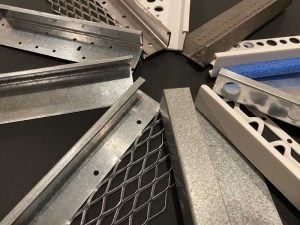 [1]
[1]By Jeff Bowlsby, CCS, CCCA
A Portland cement-based plaster (stucco) wall cladding system inherently includes its perimeter edges—where the stucco simultaneously begins, ends, and interfaces with other claddings, structural elements, penetrations, and dissimilar materials. How the stucco panel edge condition is designed and constructed critically impacts the function, performance, serviceability, durability, and aesthetics of the stucco cladding as a system, which is not widely recognized or appreciated. The casing bead, as an integral part of the stucco panel edge joint, is the second most misunderstood and misused lathing accessory after the stucco control joint. The need, essential considerations, and requirements for the effective design and installation of stucco casing beads will be presented and discussed.
History and development
The stucco trade has used several different names for the casing bead over the decades, such as J-mold, J-metal, Milcor (Milwaukee Corrugating Co.), plaster stop, termination, ground, No. 66, or just 66. Depending on whose scaffold one is on, and what region of the country one is in, these names will be interchangeable and generally refer to the same lathing accessory. The term ‘casing bead’ is presented here for consistency with the nomenclature in ASTM International industry standards, which is also consistent with most manufacturers’ product literature.
When stucco began to be used for the exterior plastering of buildings in the late 1800s, no lathing accessories existed. L.E. Curtis patented the first casing bead in 1922. It had a key attachment flange similar to the casing beads of today and a solid metal ogee profile for the panel edge. It also had a decorative quality, which is generally missing in present-day casing bead products.
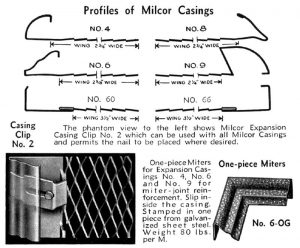 [2]
[2]Milcor was a prolific manufacturer of lathing accessories in the early 20th century which listed its products as numbers. The Milcor casing bead was available in several different profiles, each with its own number. Milcor casing bead No. 66 is the same profile today as it was nearly a century ago. Other manufacturers may have had their own lathing accessory numbering system for similar products.
Requirements in building codes and industry standards
Casing bead requirements in ASTM C1063
A primary function of the casing bead is to separate the plaster from dissimilar materials as described in ASTM C1063, Standard Specification for Installation of Lathing and Furring to Receive Interior and Exterior Portland Cement-Based Plaster. The most up-to-date text reads, “install a casing bead lathing accessory or other suitable means, at locations to separate cement plaster from dissimilar materials.”
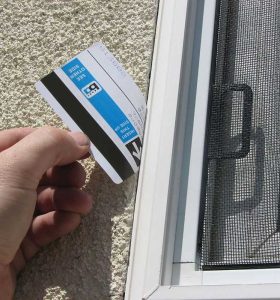 [3]
[3]These word selections have caused endless misunderstandings for both designers and stucco craftsmen. The precedent document to ASTM C1063 is ANSI A42.2-1971, Portland Cement and Portland Cement-Lime Plastering Exterior (Stucco) and Interior, which states, “where plaster abuts unplastered construction, a separation shall be provided, such as a casing bead or trowel cut.” The ‘trowel cut’ from 1971 is the ‘V-groove’ of today, and ‘unplastered construction’ from 1971 is ‘dissimilar materials’ today. A metal or nonmetallic casing bead is an integral part of the stucco cladding system, which includes lathing, lathing accessories, and portland cement-based plaster. The metal or nonmetallic casing bead is not a ‘dissimilar material’ as related to the stucco cladding, even though it is a different material from the portland cement-based plaster. It is ‘of the stucco’ as a component of the lathing and plaster system. Window, door, louver wall openings, and at piping, conduit, and similar conditions such as utility penetrations are dissimilar materials from the stucco system, which also require separation from the stucco.
Both a casing bead and a trowel cut may define the stucco panel edge. ASTM C1063 also requires a casing bead or V-groove be installed for the purpose of avoiding the transfer of structural loads to the plaster cladding.
Lastly, ASTM C1063 requires a 10 mm (0.38 in.) gap between the casing bead and the penetrating elements.
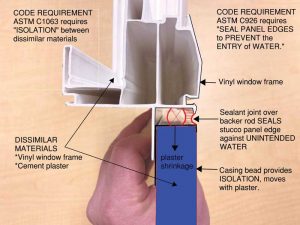 [4]
[4]Stucco thickness requirements in ASTM C926
Stucco thickness requirements are specified in ASTM C926, Standard Specification for Application of Portland Cement-Based Plaster, and an important primary function of the casing bead is to function as a screed or ground to aid the plaster craftsman in achieving required stucco thickness. The use of casing beads allows the plasterer to gauge the plastering application using the screeds to achieve a nominally uniform plaster thickness, which aids in a durable plaster application and reduced cracking.
ASTM C926 notes another primary function of the casing bead is to assist in the “sealing or caulking of V-grooved, exposed ends, and edges of stucco panels exterior work to prevent the entry of water.” The casing bead as installed along stucco panel edges functions as a surface upon which to adhere sealant between the stucco panel edge and the adjacent unplastered construction. Sealant can be designed and applied to adhere to either the casing bead at the ground surface, or at an extended capture flange surface.
 [5]
[5]To summarize, the stucco application will have panel edges abutting unplastered construction using either casing beads or V-grooves, where a 10 mm wide gap is formed at the panel edges. What to do with the gap? ASTM C926 explains how installers must “seal V-grooves, exposed ends and edges of plaster panels or exterior work to prevent the entry of water.” The sealed panel edge joint is required for the basic functional need to keep water out of the wall system, which otherwise may cause significant concealed damage if not sealed. The single most important characteristic to remember for anything portland cement-based is how it shrinks as it cures, and this shrinkage creates gaps at the adjacent unplastered construction. These gaps, which may look small, can allow a significant volume of water to bypass the stucco panel edge and collect within the wall assembly, especially during a wind-driven rain event. Sealing gaps prevents entry of excessive water and allows differential movement between the stucco and dissimilar material. This requirement exists in any jurisdiction where the local building code adopts and references the ASTM International stucco standards.
Casing bead specifications from ASTM C1861
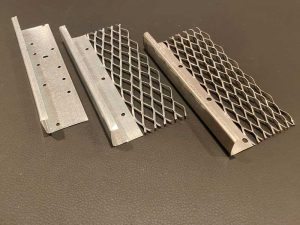 [6]
[6]It should come as no surprise to discover not all casing beads are alike. ASTM C1861, Standard Specification for Lathing and Furring Accessories, and Fasteners, for Interior and Exterior Portland Cement-Based Plaster, defines, describes, and illustrates the elements of typical casing beads. A casing bead is defined as a “lathing accessory used as a screed to assist in cement plaster thickness control; to separate cement plaster from dissimilar materials, loadbearing members, and penetrating elements; and to provide an edge, end, or termination for a cement plaster panel area.” ASTM C1861 describes and illustrates the essential elements of a casing bead as including an attachment flange, either of the solid flange or key flange type; a ground dimension, which assists in achieving the required plaster thickness; and a capture flange. The capture flange folds back onto the outermost finished surface of the plaster as a visual cover over the shrinkage gap which so often occurs. How the stucco finish coat terminates at this capture flange will determine how clean the edge of stucco will look and perform—cracking and spalling of the thin edge of stucco is common at capture flanges.
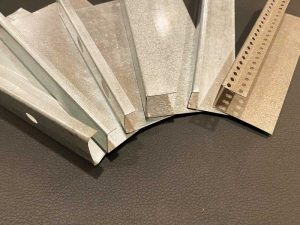 [7]
[7]Each of these three elements can vary for longer attachment flanges and a range of ground dimensions (for plaster thickness). The capture flange can be minimal for reduced visual impact or wider to function as a surface to receive sealant when plaster is perpendicular to an adjacent surface, such as at recessed wall opening returns into window frames. Perforations may be provided if the casing bead is configured correctly and is designed to provide a drainage function at the base of a panel. Many lathing accessories, including casing beads, come in a range of metal materials—galvanized steel, zinc alloy, stainless steel, galvalume, and others—as well as nonmetallic polyvinyl chloride (PVC), which is typically used in coastal environments.
The panel edge joint: Function, durability, and aesthetics
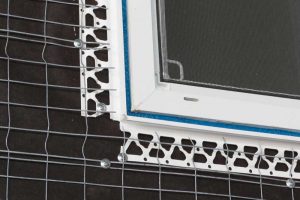 [8]
[8]It is entirely appropriate and helpful to think of the casing bead and the required sealed gap located adjacent to unplastered construction as a panel edge joint where the stucco cladding begins and ends. Understanding this assembly as a functional, purposeful panel edge joint—and not just an installed casing bead and sealant—is useful and beneficial to those who design or construct stucco claddings. It encourages one to understand the function of the joint as an assembly and not just focus on its individual parts. Without a casing bead and sealant, when the plaster shrinks away from the adjacent unplastered construction, a resulting unsealed gap often develops. Without a casing bead, required plaster thickness cannot be verified. Water can penetrate the unsealed gap, and when this happens, there may be a debate about who owns the gap. The adjacent trades will blame the other, and vice versa, for any resulting water penetration and concealed damage. Understanding the assembly of a casing bead and sealed gap as a panel edge joint provides a clear demarcation of work between different adjacent trades.
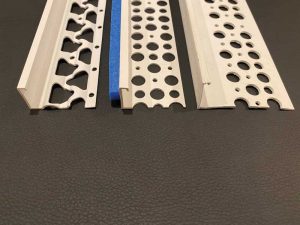 [9]
[9]The problem with stucco keys
Manufacturers of metal, PVC, and wood windows and doors each have versions of stucco keys integrated with their products. Keying the stucco to dissimilar material (i.e. the window frame) is used to eliminate the code-required, water-resistant isolation mechanism (the sealed casing bead panel edge joint) codified in the stucco industry standards as necessary “to prevent the entry of water” around windows or door frames. For this reason, they do not meet the requirements of an “other suitable means.” The concept is misguided, is an attempt to legitimize incorrect practices and violations of the code, and leaves the most vulnerable locations to water entry unprotected.
 [10]
[10]The water resistivity performance requirement in ASTM C926 is “to prevent the entry of water,” which is clearly stated and codified. Portland cement-based plaster will inevitably shrink away from windows and doors, creating a gap for water infiltration. Further, stucco keys in dissimilar components are not defined or approved as lathing accessories in either ASTM C1063 or ASTM C1861. They are ‘of the window or door’ and not ‘of the stucco.’ As an integral element of the window frame, a stucco key is not capable of providing the required separation between the window frame and the plaster edge. Stucco keys are a disservice to the stucco industry, and to building owners who suffer concealed water damage resulting from this indefensible practice.
Casing bead installation and joinery
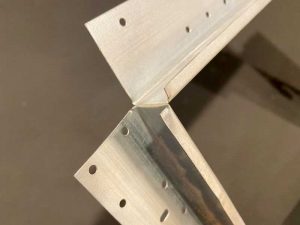 [11]
[11]Casing bead installation and joinery requires careful planning, an understanding of water management requirements, and coordination to assure the objectives of the installation are satisfied. Typical joinery consists of linear splice joints and corner joints, such as around windows, doors, and other exterior building components.
Casing beads should be constructed and installed to prevent water penetration along panel edges. This is consistent with Appendix A2.1.3 of ASTM C926, which reduces the burden on the wall’s water resistive barrier and flashing components. As Bateman and Luft illustrate, casing bead linear splice joints can be constructed in several different ways to improve water resistance of the stucco cladding system. Watertight linear splices may require splice plates, nested tabs, and sealant applied in the correct locations to be functionally effective at water management. Casing bead perimeter frames surrounding a wall opening will include corners at head/jamb and jamb/sill conditions. Simply slitting the casing beads’ attachment flange and bending it 90 degrees will result in a casing bead corner open to water infiltration. Configuring an installed casing bead with a solid attachment flange where the corners are correctly lapped and sealed may, with careful planning and execution, improve water resistance and allow integration with the water resistive barrier assembly on the wall.
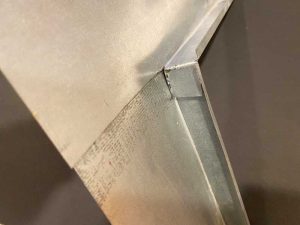 [12]
[12]Recent casing bead innovations with enhanced function and aesthetics
Based on the hundreds of patents issued for stucco-related innovations over the years, the stucco industry has a history of attracting innovators and inventors. In the last couple of years, a few notable casing bead-related products have made it to market through major manufacturers.
One manufacturer has developed a casing bead featuring an integral backer rod, which provides both the necessary gap to adjacent unplastered construction and to receive sealant. This manufacturer tested two windows installed into a laboratory test wall—one without their casing bead and sealant, and the other with their casing bead and sealant—subjecting both specimens to an ASTM E331 test. The casing bead and sealant specimen passed the test of an 80-km/h (50-mph) wind-driven rain, while the specimen without the casing bead and sealant failed in less than 15 minutes. This same manufacturer is now also producing a casing bead with a self-furring key attachment flange, to improve embedment of the casing bead. Another manufacturer is producing a casing bead with a recessed and embedded rather than exposed capture flange. This innovation accommodates a lamina base coat and eliminates the buildup and cracking typical of standard capture flange casing beads, when used with lamina base coats.
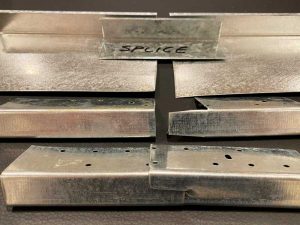 [13]
[13]Conclusion
In summary, a significant concern of building owners, designers, and stucco craftsmen is ‘stucco leaks,’ with resultant concealed water-related exterior wall damages. This is in part due to omission of the panel edge joint at stucco cladding perimeter conditions at dissimilar materials (unplastered construction), such as around windows and doors. Concealed water-related exterior wall damages can be minimized or avoided where the stucco panel edge joint consisting of casing beads and sealant to prevent the entry of water as ASTM stucco standards describe, is included as an essential subassembly of the stucco cladding system, in both design and construction.
- [Image]: https://www.constructionspecifier.com/wp-content/uploads/2022/03/Header1-300dpi.jpg
- [Image]: https://www.constructionspecifier.com/wp-content/uploads/2022/03/Fig-01-300dpi.jpg
- [Image]: https://www.constructionspecifier.com/wp-content/uploads/2022/03/Fig-02-300dpi.jpg
- [Image]: https://www.constructionspecifier.com/wp-content/uploads/2022/03/Fig-03-300dpi.jpg
- [Image]: https://www.constructionspecifier.com/wp-content/uploads/2022/03/Fig-04-300dpi.jpg
- [Image]: https://www.constructionspecifier.com/wp-content/uploads/2022/03/Fig-05-300dpi.jpg
- [Image]: https://www.constructionspecifier.com/wp-content/uploads/2022/03/Fig-06-300dpi.jpg
- [Image]: https://www.constructionspecifier.com/wp-content/uploads/2022/03/Fig-07-300dpi.jpg
- [Image]: https://www.constructionspecifier.com/wp-content/uploads/2022/03/Fig-08-300dpi.jpg
- [Image]: https://www.constructionspecifier.com/wp-content/uploads/2022/03/Fig-09-300dpi.jpg
- [Image]: https://www.constructionspecifier.com/wp-content/uploads/2022/03/Fig-10-300dpi.jpg
- [Image]: https://www.constructionspecifier.com/wp-content/uploads/2022/03/Fig-11-300dpi.jpg
- [Image]: https://www.constructionspecifier.com/wp-content/uploads/2022/03/Fig-12-300dpi.jpg
Source URL: https://www.constructionspecifier.com/stucco-metrics-the-mighty-stucco-casing-bead/
 Jeff Bowlsby, CCS, CCCA, is a licensed California architect and stucco consultant with Simpson Gumpertz & Heger, based in Northern California. He specializes in exterior wall and stucco assembly consultations to architects, contractors, developers, stucco contractors, and property owners. His nationwide practice focuses on the design of new building construction and rehabilitation projects, and forensic evaluations, specifically regarding stucco claddings. Since 2013, Bowlsby has chaired or co-chaired several ASTM International stucco committees including ASTM C1063 on Lathing Installation and is the primary author and chair of ASTM C1861 on Lathing Accessories. He also founded and chairs the national ASTM C11 Stucco Work Group, which develops all ASTM stucco-related industry standards referenced in building codes and construction contracts, and is the author of the stucco industry information resource StuccoMetrics.com.
Jeff Bowlsby, CCS, CCCA, is a licensed California architect and stucco consultant with Simpson Gumpertz & Heger, based in Northern California. He specializes in exterior wall and stucco assembly consultations to architects, contractors, developers, stucco contractors, and property owners. His nationwide practice focuses on the design of new building construction and rehabilitation projects, and forensic evaluations, specifically regarding stucco claddings. Since 2013, Bowlsby has chaired or co-chaired several ASTM International stucco committees including ASTM C1063 on Lathing Installation and is the primary author and chair of ASTM C1861 on Lathing Accessories. He also founded and chairs the national ASTM C11 Stucco Work Group, which develops all ASTM stucco-related industry standards referenced in building codes and construction contracts, and is the author of the stucco industry information resource StuccoMetrics.com.